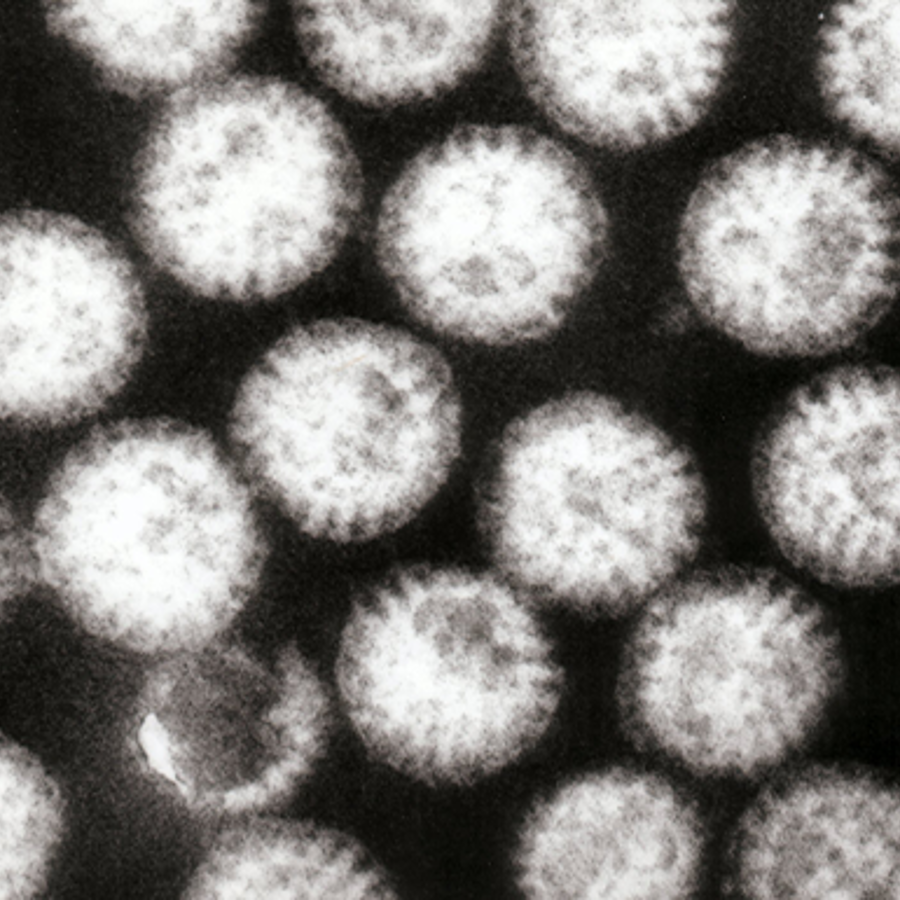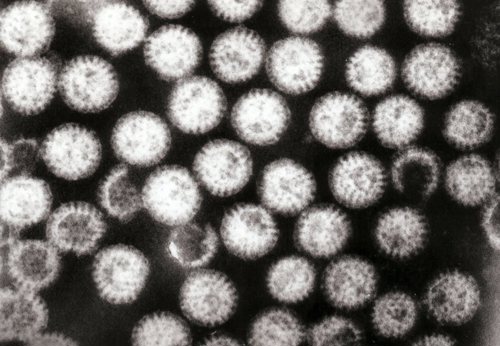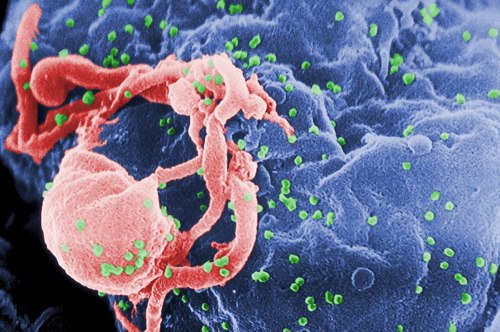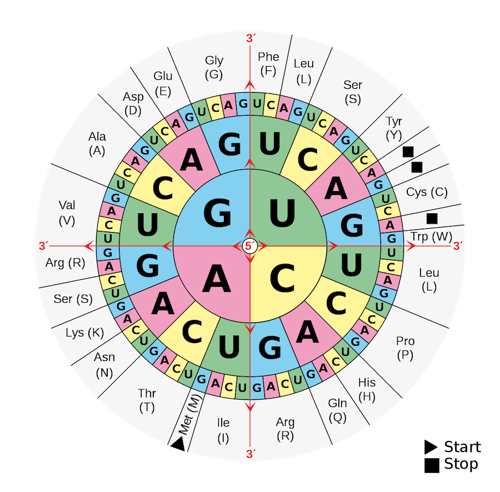
Is there some way to use genetics to wipe out all viral diseases?
February 28, 2013

- Related Topics:
- Microbiology,
- Genetic engineering,
- Bioethics,
- Futuristic science
A curious adult from California asks:
"Is there some way to use genetics to wipe out all viral diseases?"
Yes, in theory we maybe could. One way would be to make us immune to one virus at a time. Eventually we could be immune to all the viruses we could be.
Unfortunately there’d still be viruses that could infect us. There probably isn’t a simple genetic difference that will make someone immune to the flu or a common cold or a bunch of other viruses as well. To become immune to all of them, we’d need to make it so no virus can infect us. And to do that, we’d need to radically re-engineer humans.
The basic idea would be to change our cells so viruses can’t invade them anymore. Now we would be immune to all viruses.
This sounds pretty far fetched but scientists are well on their way to doing this in bacteria. If it works there, only technical (and ethical) issues will keep it from working for people.
Now having laid out these two possibilities, it is important to say that neither can be done right now. We simply do not have the technical skills to do the first one in any ethical way. And we are years (decades?) away from having the tools needed to pull off the second.

But someday we could have the skills to do this. The question will then be whether the risks of rejiggering the human race are worth the benefits of wiping out all known viral diseases. We’ll see.
Tackling Viruses One at a Time
We have already started down the path of wiping viruses out one at a time. Instead of genetics, we’ve used vaccines to do it.
We eliminated smallpox by vaccinating enough people so no one had the disease. And we are close to doing the same with polio.
So one option is to continue along this path, wiping out viral diseases one at a time. It is a tried and true strategy that will only get easier as we become a more connected world. (As long as some people don’t keep others and themselves from being vaccinated that is.)
The first genetic option is actually very similar to this. We could identify certain people who are highly resistant or immune to a disease because of their genetics and then make sure everyone has those genetics.
The only way we could do that right now is ethically unacceptable. Basically, the idea would be that only people with the right genes would be allowed to have kids. And only those embryos predicted to be immune would be implanted and allowed to grow. As I said, this is morally reprehensible and should not be done.
In fact, it isn’t even in the best interest of the human race in general. So few people are immune to any one virus that we would lose a whole lot of our genetic diversity if we headed down this path. In other words, we would lose lots of useful traits on the way to being immune. We would end up weaker both physically and morally in the end.
Another way would be to genetically engineer people to be resistant to each viral disease separately. We can’t do this right now as we just don’t have the technical skills to make subtle genetic changes in people. But it would be theoretically possible.
What we’d do is identify a genetic difference that makes someone immune and then engineer that difference in all embryos. In the end we’d have a human race immune to that virus (until it mutated to get past that change).
A great candidate for this would be the delta 32 version of the CCR5 gene. People who only have this version of the gene are highly resistant to HIV, the virus that causes AIDS. If we all had this genetic difference, HIV wouldn’t stand a chance. (Until, again, it mutated in a way that it could get around this difference.)

A combination of vaccines and genetic changes could help us with lots of different viruses, but not all of them. The cold, the flu, rabies and a few others would still be around.
To get rid of these, we’d need something more radical. Something on the order of thousands of genetic changes that essentially makes humans separate from the rest of nature. A brave new world indeed.
Tackling Viruses all at Once
As I said, making humans immune to all viruses needs a radical makeover of how our cells work. In essence, we need to have them speak a different language than all the other cells on Earth.
The vast majority of living creatures are run on the genetic code. This language is shared by bacteria, banyan trees, bonobos and most everything else including viruses.
If we “teach” our cells a different language, viruses won’t be able to hijack them anymore. The virus will get into the cell and then not be able to grow or spread.

Let’s think about it this way. Imagine you have to set up an assembly line that puts together something complicated like a car. You have all the supplies stacked in the middle of a giant warehouse but the instructions are in Japanese. And you only speak English.
It would be very hard to create the assembly line and start making cars. A virus would be in a similar position if we changed how the instructions in our DNA are read.
See, a virus infects a cell by hijacking the cell’s machinery. Basically it uses a cell’s machinery against it.
The cell follows the viral instructions and cranks out lots of new viruses. This is how viruses cause disease and spread.
To do this, the virus and the cell have to speak the same language. The virus has to be able to give commands the cell can understand.
If we can teach our cells to speak a different language, then we will be immune to viruses. Luckily we don’t need to speak a completely different language. We can just tweak ours a bit…sort of a different dialect of the genetic code.
Our genetic code uses the simple four letter alphabet of DNA—A, T, C, and G—to make up 64 three letter words. Fortunately, this language has a lot of synonyms—lots of words mean the same thing.
So what we can do is substitute one synonym for another and then change the meaning of the original word to something else. This simple change should be enough to make the genetic code incomprehensible to the virus.
The best words would be those that sort of act like periods because there is only one per gene. There are three of these “stop codons”—TAG, TAA, and TGA. We’ll focus on TAG.
The first thing we’d do is change all the TAG’s at the end of genes to TAA’s and TGA’s. All three of these act as periods so it shouldn’t affect anything too severely.
Next we would change the cell’s machinery so it used the TAG for something else. Now when a virus invades, instead of stopping at a TAG at the end of a gene, it’ll keep going until the next TAA or TGA. Its instructions have turned into run-on sentences which, as you’ll see, is a bigger deal in biology than it is grammatically.

See, the instructions are actually genes here. A gene has the instructions for making a protein and a protein is a piece of machinery that needs a precise shape to work right. If its instructions don’t stop in the right place, it ends up with lots of extra bits stuck to it. This results in a misshapen protein that can’t do its job anymore.
For a virus that means the proteins that make it up are wrong. Now we have a poorly put together virus that can’t invade anymore. Our assembly line is cranking out defective cars.
Now this almost certainly wouldn’t be enough. Viruses are small and mutate like mad so a virus would quickly get past a “simple” change like this. We’d need to change the meanings of some other words too if we want to stay immune to viruses for a long time.
Sounds great, let’s get started! Not so fast…
A Ways To Go
We are a long way from rewriting our genetic code. We have around 21,000 genes so we’d probably need to change TAG to TAA or TGA in 5,000-7,000 of them. We’d also need to change the TAG machinery. Oh and we’d also need to change over thousands of other words too so we could be more or less permanently resistant to the viruses. This is way beyond what we can do.
Even if we could make all the necessary changes, there is no guarantee it would work. First off, we may not have found all the genes or pieces of DNA where reading TAG are important. The engineered human with some extra TAGs would not survive long. This is an unacceptable risk for the test humans.
Secondly, some of these words may not actually be as similar as we think. Some recent work suggests that which of the many words with the same meaning is chosen matters in some genes. It may be that we mess things up by changing “good” to “excellent.”
Not only that but even if we managed to find every important TAG and found that changing over a bunch of codons was OK, we would still need to be sure not to make too many mistakes when making the changes. Since these changes are in genes, some mistakes could lead to deformities, disease, and or death. Again, not great from a moral standpoint.
And finally, even if we managed to make a human with a different dialect of the genetic code, viruses would probably eventually adapt. In our example, they’d simply learn Japanese!
This wouldn’t be easy but nature is incredibly tricky. A virus somewhere would eventually mutate to the point where we were susceptible again.
So I guess we’ll cross this bridge when we come to it. We can’t do any of this right now, but someday we will be able to. We will be able to separate man from the rest of nature.

Author: Dr. D. Barry Starr
Barry served as The Tech Geneticist from 2002-2018. He founded Ask-a-Geneticist, answered thousands of questions submitted by people from all around the world, and oversaw and edited all articles published during his tenure. AAG is part of the Stanford at The Tech program, which brings Stanford scientists to The Tech to answer questions for this site, as well as to run science activities with visitors at The Tech Interactive in downtown San Jose.
 Skip Navigation
Skip Navigation
